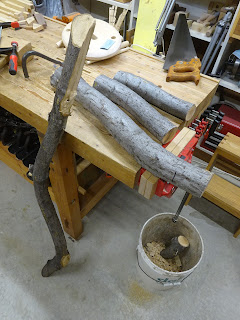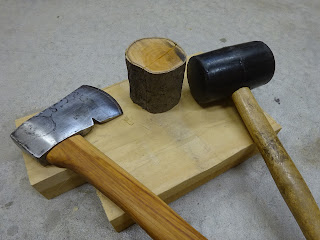Oh, how I wish for more space. It'd be great to have a full size shaving horse, but I just don't need one badly enough to justify the space it would take up. I've been thinking about it a long time and finally decided to do something as a substitute. The internet shows folding shave horses, bench-mounted shave ponies, vise-mounted shave ponies and other devices you can build that are space-saving solutions. Here's what I came up with.
 |
| Here's the setup |
It's basically a chunk of wood (the base) clamped in a bench vise, with a clamping frame that pivots via dowels through the base to put pressure on a workpiece when the foot treadle is pushed forward.
There were a lot of considerations with this. If I mounted it in my tail vise (as shown above), the bench would get pulled out of position. Even though my bench is pretty heavy, it'll still move when yanking on wood with a drawknife. So if it was to be vise-mounted, it would be better to have it in the front vise. I can still do that, but will probably use it in the tail vise due to space limitations to the left of my front vise.
At first, I thought it might be nice to have the option to stand or sit when using it. But I can tell already that it is far more comfortable when sitting. The nice thing about mounting it in a vise is that I can angle the base as needed to accommodate a comfortable drawknife pull stroke.
Then there's things like the length and front-to-back location of the treadle frame. I decided to make it long and adjustable. Even after just a short time using it, some of these considerations are fleshing themselves out.
Here's how it was made - all scrap wood as usual. The base is a chunk of 5" wide, 1 5/8" thick redwood, originally 50" long that I eventually cut down to 25". This could probably have been just 18". This piece clamps into a vise. Starting about 3"-4" from the front end, I bored 5 holes at 1" intervals through the width of the board.
 |
| Base board with guide lines on top, three holes bored through so far |
 |
| For the vertical alignment, I placed a mirror a few feet to my right and tried to see if the auger bit was parallel to the stick of wood. |
 |
| Here's a close-up of the mirror - see the auger bit? - looks like I'm aiming a bit high (the clamps are holding the base to my workbench) |
After boring more than half-way, I flipped the board and came the rest of the way from the other side. The 7/16" holes weren't perfectly straight, but good enough. I did have to shave down the 7/16" oak dowels that I made to slide through there a bit easier.
The clamping mechanism is like on English shave horses, with uprights that straddle the base. There are 5 holes to adjust the position of the pivot point for when working on thicker or thinner stock. Above those holes is a single hole, through which a dowel fits that holds the clamping block.
 |
| You can see the adjustment holes for the pivot point as well as for the treadle |
 |
| Chiseled a V-shaped groove in the base as well as in the clamping block for holding a piece in a "diamond" shape when working on corners of a blank. |
I eased the corners of these V grooves, though the base is soft redwood and the clamping block is soft pine, so there's little chance of ever marring a workpiece on the edge of a V groove.
After getting a little practice using thicker and thinner stock, it became a drag to pull out the pivot pin and raise or lower the clamping frame. So I found that setting it up for thicker stock and putting in a wedge-shaped piece of wood to raise up a thin workpiece worked great. It doesn't even have to be wedge-shaped - it could be flat. It just needs to raise the workpiece up a little.
 |
| Wedge-shaped shim used to raise the workpiece so clamping is a breeze |
There are two more points of adjustability. First, there are five holes in the base for the pivot pin. I found the hole furthest forward to be best - it was better to clamp the workpiece close to the front end of the base. Second, the clamping bar is about 1.5" square. The hole through which the dowel extends is offset from center so that it is centered 9/16" from one face, 11/16" from another face, 13/16" from the third face and 15/16" from the fourth face. By rotating the clamp bar, you get as much as 3/8" of adjustability for different sized workpieces.
One thing about this design: the clamping frame is far taller than on a traditional shave horse. This allows you to get tremendous leverage on a workpiece - it holds like crazy. But if it's not set up just right, you have to extend your foot farther than is comfortable to actuate the clamp. I put the treadle bar - which is just another 7/16" dowel - at the highest hole setting that I bored. I may end up cutting these uprights a little shorter. And I might also attach a piece of wood near the bottom of the uprights that extends forward (towards my foot).
Some final touches included making knobs for the dowels so they're easier to remove and insert, and rounding over the tops of the uprights, which adds comfort and gives a little more room to fit a drawknife when the clamp is engaged.
 |
| Knobs for the dowels, round-over on the uprights |
And this job's a good'n. Now if I could just get some straight-grained green wood out here in CA. Hopefully more on that to come.
































